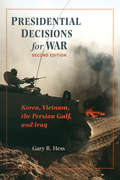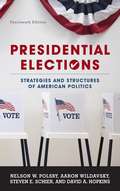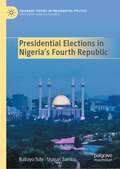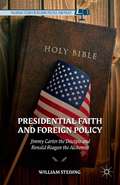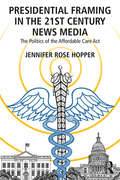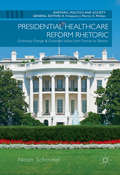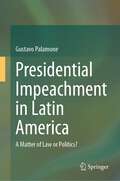- Table View
- List View
Presidential Crisis Rhetoric and the Press in the Post-Cold War World (Praeger Series in Political Communication)
by Jim A. KuypersKuypers combines rhetorical theory and framing analysis in an examination of the interaction of the press and the president during international crisis situations in the post-Cold War world. Three crises are examined: Bosnia, Haiti, and the North Korean nuclear capability issue. Kuypers effectively demonstrates the changed nature of presidential crisis rhetoric since the end of the Cold War.Kuypers employs a new historical/critical approach to analyze both the press and the Clinton administration's handling of three international crisis situations. Using case studies of Bosnia, Haiti, and the alleged North Korean nuclear buildup in 1993, he examines contemporary presidential crisis communication and the agenda-setting and agenda-extension functions of the press.The importance of this study lies in its timeliness; President Clinton is the first atomic-age president not to have the Cold War meta-narrative to use in legitimating international crises. Prior studies in presidential crisis rhetoric found that the president received broad and consistent support during times of crisis. Kuypers found that the press often advanced an oppositional frame to that used by the Clinton administration. The press frames were found to limit the options of the President, even when the press supported a particular presidential strategy. This is a major study that will be of interest to scholars and researchers of the press, the modern presidency, and American foreign policy.
Presidential Decisions for War: Korea, Vietnam, the Persian Gulf, and Iraq (The American Moment)
by Gary R. HessFollowing World War II, Americans expected that the United States would wage another major war against a superpower. Instead, the nation has fought limited wars against much weaker states, such as North Korea, North Vietnam, and Iraq. This revised and updated edition of Presidential Decisions for War analyzes the means by which four presidents have taken the nation to war and assesses the effectiveness of each president's leadership during those conflicts. Gary Hess recreates the unfolding crises in Korea, Vietnam, and Iraq to probe the reasons why Presidents Truman, Johnson, George H. W. Bush, and George W. Bush and their advisors decided in favor of war. He compares the performance of the commanders-in-chief and evaluates how effectively each understood U.S. interests, explored alternatives to war, adhered to constitutional processes, and built congressional, popular, and international support. A new conclusion points out, that unlike the administrations of Truman, Johnson, and the elder Bush, George W. Bush's White House actively sought to change the international order through preemptive war and aggressive democracy building. Fully revised and featuring an examination of how each of the presidents learned from history and juggled the demands on diplomacy, this comparative study of presidential war-making elucidates how effective executive leadership—or its absence—directly affects the outcome of wars.
The Presidential Difference: Leadership Style from FDR to Barack Obama, Third Edition
by Fred I. GreensteinFred I. Greenstein has long been one of our keenest observers of the modern presidency. In The Presidential Difference, he provides a fascinating and instructive account of the presidential qualities that have served well and poorly in the Oval Office, beginning with Franklin D. Roosevelt's first hundred days. He surveys each president's political skill, vision, cognitive style, organizational capacity, ability to communicate, and emotional intelligence--and argues that the last is the most important in predicting presidential success. Throughout, Greenstein offers a series of bottom-line judgments on each of his thirteen subjects as well as an overarching theory of why presidents succeed or fail. In this new edition, Greenstein assesses President George W. Bush in the wake of his two terms. The book also includes a new chapter on the leadership style of President Obama and how we can expect it to affect his presidency and legacy.
The Presidential Difference: Leadership Style from FDR to Barack Obama, Third Edition
by Fred I. GreensteinFred I. Greenstein has long been one of our keenest observers of the modern presidency. In The Presidential Difference, he provides a fascinating and instructive account of the presidential qualities that have served well and poorly in the Oval Office, beginning with Franklin D. Roosevelt's first hundred days. He surveys each president's political skill, vision, cognitive style, organizational capacity, ability to communicate, and emotional intelligence--and argues that the last is the most important in predicting presidential success. Throughout, Greenstein offers a series of bottom-line judgments on each of his thirteen subjects as well as an overarching theory of why presidents succeed or fail. In this new edition, Greenstein assesses President George W. Bush in the wake of his two terms. The book also includes a new chapter on the leadership style of President Obama and how we can expect it to affect his presidency and legacy.
The Presidential Dilemma: Revisiting Democratic Leadership in the American System
by Michael GenoveseThis brief, thought-provoking text evaluates the performance of recent presidents from Johnson to Bush, finding that, overall, each has failed to live up to public expectations. Written by one of the top presidency scholars today, The Presidential Dilemma reflects on the idea that as our country's problems grow, our politicians seem to shrink. Arguing that American presidents of the last 40 years have largely failed to meet the needs, expectations, and responsibilities placed upon them, the book discusses how presidents might better maximize their opportunities for leadership and suggests a distinctive theory of presidential politics: presidents, facing a system of multiple veto points, seek to maximize power and influence.The third edition of Genovese's stimulating book is thoroughly updated to reflect presidential development in recent years, and a new introduction brings his arguments current. As he demonstrates, the emergence of democracy as a new social and political paradigm undermined traditional authority and legitimacy. Subjects no longer automatically follow; now citizens must be persuaded. They may give to a leader their authority and power, or not. As Genovese notes, in a world of mass consumerism, those wishing to lead have precious little to offer by way of inducement.Genovese's goal is to examine the reasons why the performance of recent presidents has been underwhelming, discuss how they might maximize their opportunities for leadership, and ask a key question: Can presidents be both powerful and accountable? The book follows a clear format and tries to show why America's officeholders have so rarely been leaders and how presidents can become leaders instead of mere officeholders.
The Presidential Dilemma: Revisiting Democratic Leadership in the American System
by Michael GenoveseThis brief, thought-provoking text evaluates the performance of recent presidents from Johnson to Bush, finding that, overall, each has failed to live up to public expectations. Written by one of the top presidency scholars today, The Presidential Dilemma reflects on the idea that as our country's problems grow, our politicians seem to shrink. Arguing that American presidents of the last 40 years have largely failed to meet the needs, expectations, and responsibilities placed upon them, the book discusses how presidents might better maximize their opportunities for leadership and suggests a distinctive theory of presidential politics: presidents, facing a system of multiple veto points, seek to maximize power and influence.The third edition of Genovese's stimulating book is thoroughly updated to reflect presidential development in recent years, and a new introduction brings his arguments current. As he demonstrates, the emergence of democracy as a new social and political paradigm undermined traditional authority and legitimacy. Subjects no longer automatically follow; now citizens must be persuaded. They may give to a leader their authority and power, or not. As Genovese notes, in a world of mass consumerism, those wishing to lead have precious little to offer by way of inducement.Genovese's goal is to examine the reasons why the performance of recent presidents has been underwhelming, discuss how they might maximize their opportunities for leadership, and ask a key question: Can presidents be both powerful and accountable? The book follows a clear format and tries to show why America's officeholders have so rarely been leaders and how presidents can become leaders instead of mere officeholders.
Presidential Elections: Strategies and Structures of American Politics (Fourteenth Edition) (PDF)
by Nelson W. Polsby Aaron Wildavsky Steven E. Schier David A. HopkinsBrimming with data and examples from the 2008 and 2012 elections, and laced with previews of 2016, the fourteenth edition of this classic text offers a complete overview of the presidential election process from the earliest straw polls and fundraisers to final voter turnout and exit interviews. The comprehensive coverage includes campaign strategy, the sequence of electoral events, and the issues, all from the perspective of the various actors in the election process: voters, interest groups, political parties, the media, and the candidates themselves.
Presidential Elections and Majority Rule: The Rise, Demise, and Potential Restoration of the Jeffersonian Electoral College
by Edward B. FoleyThe Electoral College that governs America has been with us since 1804, when Thomas Jefferson's supporters redesigned it for his re-election. The Jeffersonians were motivated by the principle of majority rule. Gone were the days when a president would be elected by acclamation, as George Washington had been. Instead, given the emergence of intense two-party competition, the Jeffersonians wanted to make sure that the Electoral College awarded the presidency to the candidate of the majority, rather than minority, party. They also envisioned that a candidate would win by amassing a majority of Electoral College votes secured from states where the candidate's party was in the majority. For most of American history, this system has worked as intended, producing presidents who won Electoral College victories derived from state-based majorities. In the last quarter-century, however, there have been three significant aberrations from the Jeffersonian design: 1992, 2000, and 2016. In each of these years, the Electoral College victory depended on states where the winner received only a minority of votes. In this authoritative history of the American Electoral College system, Edward Foley analyzes the consequences of the unparalleled departure from the Jeffersonians' original intent-and delineates what we can do about it. He explains how states, by simply changing their Electoral College procedures, could restore the original Jeffersonian commitment to majority rule. There are various ways to do this, all of which comply with the Constitution. If only a few states had done so before 2016, the outcome might have been different. Doing so before future elections can prevent another victory that, contrary to the original Jeffersonian intent, a majority of voters did not want.
Presidential Elections and Majority Rule: The Rise, Demise, and Potential Restoration of the Jeffersonian Electoral College
by Edward B. FoleyThe Electoral College that governs America has been with us since 1804, when Thomas Jefferson's supporters redesigned it for his re-election. The Jeffersonians were motivated by the principle of majority rule. Gone were the days when a president would be elected by acclamation, as George Washington had been. Instead, given the emergence of intense two-party competition, the Jeffersonians wanted to make sure that the Electoral College awarded the presidency to the candidate of the majority, rather than minority, party. They also envisioned that a candidate would win by amassing a majority of Electoral College votes secured from states where the candidate's party was in the majority. For most of American history, this system has worked as intended, producing presidents who won Electoral College victories derived from state-based majorities. In the last quarter-century, however, there have been three significant aberrations from the Jeffersonian design: 1992, 2000, and 2016. In each of these years, the Electoral College victory depended on states where the winner received only a minority of votes. In this authoritative history of the American Electoral College system, Edward Foley analyzes the consequences of the unparalleled departure from the Jeffersonians' original intent-and delineates what we can do about it. He explains how states, by simply changing their Electoral College procedures, could restore the original Jeffersonian commitment to majority rule. There are various ways to do this, all of which comply with the Constitution. If only a few states had done so before 2016, the outcome might have been different. Doing so before future elections can prevent another victory that, contrary to the original Jeffersonian intent, a majority of voters did not want.
Presidential Elections in Mexico: From Hegemony to Pluralism
by Reynaldo Yunuen Ortega OrtizThis book analyzes the transformation of the Mexican political system during the last four decades, focusing on its presidential elections. As the country has shifted away from an authoritarian political system, ruled by a hegemonic party, it has become a more moderate, pluralistic society, marked by electoral competition between contestant parties. Using a mixed methodology, including historical and statistical analysis, the author argues that the fight for clean and fair elections in Mexico has a long history of contestation and conflict, entailing at once movements towards democracy yet also processes of de-democratization.”
Presidential Elections in Mexico: From Hegemony to Pluralism
by Reynaldo Yunuen Ortega OrtizThis book analyzes the transformation of the Mexican political system during the last four decades, focusing on its presidential elections. As the country has shifted away from an authoritarian political system, ruled by a hegemonic party, it has become a more moderate, pluralistic society, marked by electoral competition between contestant parties. Using a mixed methodology, including historical and statistical analysis, the author argues that the fight for clean and fair elections in Mexico has a long history of contestation and conflict, entailing at once movements towards democracy yet also processes of de-democratization.”
Presidential Elections in Nigeria's Fourth Republic (Palgrave Studies in Presidential Politics)
by Babayo Sule Usman SamboThis book provides a uniquely detailed analysis of presidential elections in Nigeria’s Fourth Republic. The authors explore the changing dynamics of voting patterns, religious politics, politicians’ behaviour and the broader political system to offer new insights into presidential systems in Africa and beyond. In doing so, they address an often-neglected area of political science and cast light on the political challenges facing one of the world’s largest democracies. The book’s comprehensive coverage of Nigerian presidential elections – and the lessons they hold for developing countries across the globe – is a valuable resource for researchers, students, international institutions and non-governmental organisations.
The Presidential Expectations Gap: Public Attitudes Concerning the Presidency
by Richard Waterman Carol L Silva Hank Jenkins-SmithFor decades, public expectations of U.S. presidents have become increasingly excessive and unreasonable. Despite much anecdotal evidence, few scholars have attempted to test the expectations gap thesis empirically. This is the first systematic study to prove the existence of the expectations gap and to identify the factors that contribute to the public’s disappointment in a given president. Using data from five original surveys, the authors confirm that the expectations gap is manifest in public opinion. It leads to lower approval ratings, lowers the chance that a president will be reelected, and even contributes to the success of the political party that does not hold the White House in congressional midterm elections. This study provides important insights not only on the American presidency and public opinion, but also on citizens’ trust in government.
Presidential Faith and Foreign Policy: Jimmy Carter the Disciple and Ronald Reagan the Alchemist (Palgrave Studies in Religion, Politics, and Policy)
by W. StedingThis book explores the relationship between the religious beliefs of presidents and their foreign policymaking. Through the application of a new methodological approach that provides a cognetic narrative of each president, this study reveals the significance of religion's impact on U.S. foreign policy.
Presidential Framing in the 21st Century News Media: The Politics of the Affordable Care Act
by Jennifer Rose HopperThe Patient Protection and Affordable Care Act came into existence at a time when the president’s ability to lead the public was in question, political polarization had intensified, and the media environment appeared ever more fragmented, fast-moving, and resistant to control. Under such circumstances, how can contemporary American presidents such as Barack Obama build and maintain support for themselves and their policies, particularly as controversies arise? Using case studies of major contests over how key elements of the Affordable Care Act would be framed, and analysis of how those frames fared in influential and popular U.S. news sources, Hopper examines the conditions under which the president can effectively shape public debates today. She argues that despite the difficult political and communications context, the president retains substantial advantages in framing major controversial issues for the media and the public. These presidential framing advantages are conditional, however, and Hopper explores the factors that help make presidential frames more or less likely to gain hold in the news today. More so than in the past, an element of unpredictability in this news environment means that in pursuing favorable messaging, the president and his surrogates may also generate some unintentional consequences in how issues are portrayed to the public. Presidential frames can evolve with unfolding events to take on new meanings and applications, a process facilitated alternately by supporters, opponents, and media actors. Still, media figures and political opponents remain largely reactive to presidential communications, even as some seek to publicize and exploit weaknesses in the administration’s narratives. A close look at these recent cases casts new light on the scholarly debate surrounding the president’s ability to persuasively communicate and challenges conventional wisdom that the 21st century media largely present an unmanageable news environment for the White House. Presidential Framing in the 21st Century News Media engages with current events in American politics, focusing on the Obama Administration and the Affordable Care Act, while also reflecting upon the state of the American presidency, the news media, and the public in ways that have substantial implications for all of these actors, not merely in the present, but into the future, making it a compelling read for scholars of Political Science, Media Studies, Communication Studies, and Public Policy.
Presidential Framing in the 21st Century News Media: The Politics of the Affordable Care Act
by Jennifer Rose HopperThe Patient Protection and Affordable Care Act came into existence at a time when the president’s ability to lead the public was in question, political polarization had intensified, and the media environment appeared ever more fragmented, fast-moving, and resistant to control. Under such circumstances, how can contemporary American presidents such as Barack Obama build and maintain support for themselves and their policies, particularly as controversies arise? Using case studies of major contests over how key elements of the Affordable Care Act would be framed, and analysis of how those frames fared in influential and popular U.S. news sources, Hopper examines the conditions under which the president can effectively shape public debates today. She argues that despite the difficult political and communications context, the president retains substantial advantages in framing major controversial issues for the media and the public. These presidential framing advantages are conditional, however, and Hopper explores the factors that help make presidential frames more or less likely to gain hold in the news today. More so than in the past, an element of unpredictability in this news environment means that in pursuing favorable messaging, the president and his surrogates may also generate some unintentional consequences in how issues are portrayed to the public. Presidential frames can evolve with unfolding events to take on new meanings and applications, a process facilitated alternately by supporters, opponents, and media actors. Still, media figures and political opponents remain largely reactive to presidential communications, even as some seek to publicize and exploit weaknesses in the administration’s narratives. A close look at these recent cases casts new light on the scholarly debate surrounding the president’s ability to persuasively communicate and challenges conventional wisdom that the 21st century media largely present an unmanageable news environment for the White House. Presidential Framing in the 21st Century News Media engages with current events in American politics, focusing on the Obama Administration and the Affordable Care Act, while also reflecting upon the state of the American presidency, the news media, and the public in ways that have substantial implications for all of these actors, not merely in the present, but into the future, making it a compelling read for scholars of Political Science, Media Studies, Communication Studies, and Public Policy.
Presidential Government
by Benjamin GinsbergNoted political scientist Benjamin Ginsberg has written an essential text for courses on the United States presidency. An invaluable resource, Ginsberg’s comprehensive analysis emphasizes the historical, constitutional, and legal dimensions of presidential power. He explores the history and essential aspects of the office, the president’s relationship to the rest of the executive branch and to a subordinated Congress, and the evolution of the American president from policy executor to policy maker. Compelling photo essays delve into topics of special interest, including First Spouses, Presidential Eligibility, and Congressional Investigations of the White House.
Presidential Healthcare Reform Rhetoric: Continuity, Change & Contested Values from Truman to Obama (Rhetoric, Politics and Society)
by Noam SchimmelThis book analyzes the rhetorical strategies employed by the four Democratic presidents, Truman, Johnson, Clinton and Obama, who tried to expand access to and affordability of healthcare in the United States. It considers how they made such arguments, the ethics they advanced, and the vision of America they espoused. The author combines rhetoric analysis, policy analysis, and policy history to illuminate the dynamic nature of the way American presidents have imagined the moral and social bonds of the American people and their exhortations for governance and policy to reflect and honor these bonds and obligations. Schimmel illustrates how Democratic presidents invoke positive liberty and communitarian values in direct challenge to opposing conservative ideologies of limited government and prioritization of negative liberty and their increasing prominence in the post-Reagan era. He also draws attention to the ethical and policy compromises entailed by the usage of specific rhetorical strategies and their resulting discursive effects.
The Presidential Image: A History from Theodore Roosevelt to Donald Trump
by Iwan Morgan Mark WhitePresidential Image has become an integral part of the campaign, presidency and legacy of Modern American presidents. Across the 20th century to the age of Trump, presidential image has dominated media coverage and public consciousness, winning elections, gaining support for their leadership in office and shaping their reputation in history.Is the creation of the presidential image part of a carefully conceived public relations strategy or result of the president's critics and opponents? Can the way the media interpret a presidents' actions and words alter their image? And how much influence do cultural outputs contribute to the construction of a presidential image?Using ten presidential case studies. this edited collection features contributions from scholars and political journalists from the UK and America, to analyse aspects of Presidential Image that shaped their perceived effectiveness as America's leader, and to explore this complex, controversial, and continuous element of modern presidential politics.
The Presidential Image: A History from Theodore Roosevelt to Donald Trump
by Iwan Morgan Mark WhitePresidential Image has become an integral part of the campaign, presidency and legacy of Modern American presidents. Across the 20th century to the age of Trump, presidential image has dominated media coverage and public consciousness, winning elections, gaining support for their leadership in office and shaping their reputation in history.Is the creation of the presidential image part of a carefully conceived public relations strategy or result of the president's critics and opponents? Can the way the media interpret a presidents' actions and words alter their image? And how much influence do cultural outputs contribute to the construction of a presidential image?Using ten presidential case studies. this edited collection features contributions from scholars and political journalists from the UK and America, to analyse aspects of Presidential Image that shaped their perceived effectiveness as America's leader, and to explore this complex, controversial, and continuous element of modern presidential politics.
Presidential Impeachment in Latin America: A Matter of Law or Politics?
by Gustavo PalamoneThis book pursues a comparative and interdisciplinary approach to assess presidential impeachments in Latin America. Mixing methodologies from legal studies and political science, it provides a novel and comprehensive assessment of some of the most controversial questions regarding the constitutional function of impeachment and its place in the theory of government.Presidential impeachments have become frequent in Latin America, yet they are still largely misunderstood by legal practitioners and the general public. As such, impeachments frequently provide for heated and polarizing debates. The misunderstandings stem from skewed expectations arising from different theories of government, legal interpretation, and presidential impeachment. The empirical evidence and arguments presented here will help to find common ground on these topics and pacify some latent tensions in society and academia. In addition, the book’s case studies cover cases that have been rarely or incompletely addressed in the literature. Some cover events so recent that they have never been analyzed elsewhere.The book proposes reconsidering certain assumptions made about systems of government, which are based on skewed expectations of impeachments. It also draws on new evidence to re-examine existing impeachment theories and develop new ones. By doing so, it offers valuable insights that may guide lawmakers to redesign their own systems, optimizing them to achieve certain goals. It will also acquaint legal practitioners with the strategies of prosecution, defense, and decision-making in connection with impeachments.
Presidential Leadership: Politics And Policy Making (PDF)
by George C. Edwards Kenneth R. Mayer Stephen J. WayneWith a focus on presidential leadership, the authors address the capacity of chief executives to fulfill their tasks, exercise their powers, and utilize their organizational structures to affect the output of government. The authors examine all aspects of the presidency in rich detail, including the president's powers, presidential history, and the institution of the presidency. Guiding their analysis is their unique contrast between two broad perspectives on the presidency-the constrained president ("facilitator") and the dominant president ("director")-making the text a perennial favorite for courses on the presidency. The authors richly illustrate their engaging analysis with timely, fascinating examples. They fully integrate the Trump presidency into every chapter, offering wide-ranging coverage. Moreover, they devote separate chapters to essential aspects of President Trump's approach to governing such as on media relations, leading the public, and decision making. Equally important, they incorporate the most recent scholarship and their own unique approach to show how the Trump presidency illuminates our basic understanding of the presidency, making Presidential Leadership the perfect vehicle for understanding the president and his impact on the office.
Presidential Leadership: The Political Relations of Congress and the Chief Executive
by Pendleton HerringThe nature of the presidency is an issue that has been debated since the drafting of the United States Constitution. The Federalists felt a strong executive was the backbone and prime mover of a strong government. On the other side, the Anti-Federalists felt the presidency represented monarchical tendencies and could potentially subvert republican government. How does executive leadership fit in with a limited government with enumerated powers? Does the Constitution require a containment of executive power, even during times of crisis, or do times of crisis warrant an abandonment of a strict legalistic reading of the document?
Presidential Leadership: The Political Relations of Congress and the Chief Executive
by Pendleton HerringThe nature of the presidency is an issue that has been debated since the drafting of the United States Constitution. The Federalists felt a strong executive was the backbone and prime mover of a strong government. On the other side, the Anti-Federalists felt the presidency represented monarchical tendencies and could potentially subvert republican government. How does executive leadership fit in with a limited government with enumerated powers? Does the Constitution require a containment of executive power, even during times of crisis, or do times of crisis warrant an abandonment of a strict legalistic reading of the document?
Presidential Leadership and National Security: The Obama Legacy and Trump Trajectory
by Richard S. ConleyThis book assesses the foreign policy legacy of the Obama administration through the lens of national security and leadership. Timely, accessible chapters authored by leading scholars of presidential and international politics cover White House-Cabinet relations; Congress and War Powers; challenges including the Iran nuclear deal, ISIS, and the closing of Guantanamo Bay; drone strikes; the New Cold War with Russia; and the ways in which the Obama foreign policy legacy shaped the 2016 presidential election. In particular, the book explores the philosophical basis of counter-terrorism strategy in the Obama administration and traces how precepts differed from the administration of George W. Bush. More generally, the book contributes to an understanding of the distinctive interplay between the formal, constitutional powers of the president and the use of informal, executive powers in the quest for peace and security. Finally, the book surveys the challenges that Donald J. Trump faces in the transition to the new presidential administration.

